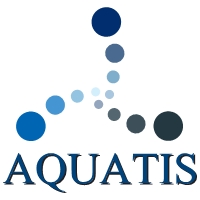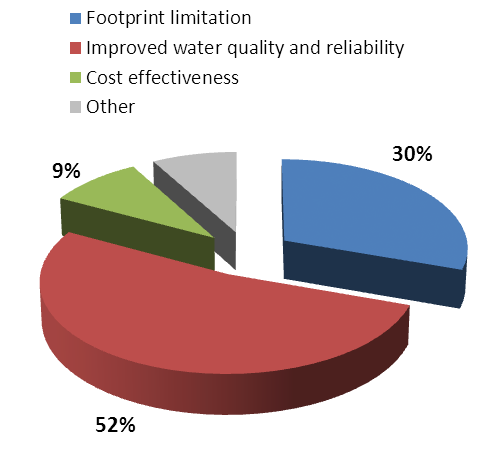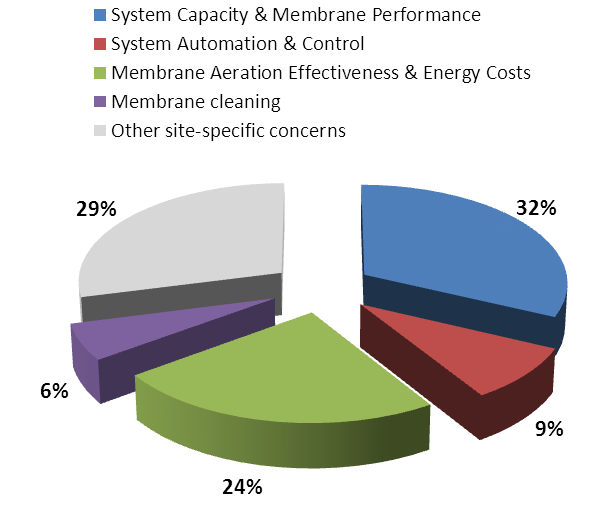This part was adapted from “The MBR Book (Simon Judd), Elsevier, 2011” and completed with data provided by Pierre Leclerch from the university of NSW and JC Schrotter from Aquatis. More information can also be found at www.thembrsite.com
Although the main drivers for MBR technology are similar to those worldwide, water scarcity is a key factor in Australia. The main specific drivers and challenges are presented in Figure 1 and Figure 2 and may be summarized as follows:
- Water recycling initiatives, partly driven by constraints on discharge to receiving waters and partly by scarcity of freshwater or efficiency improvements within industry. The high quality of treated water from MBR systems is an obvious advantage for water recycling, and this typically includes low concentrations of solids and pathogens in the MBR permeate. Furthermore, chemically assisted MBRs can also achieve very low phosphate concentrations in the permeate, potentially eliminating pre-treatment for water reclamation processes where inorganic scaling of reverse osmosis membranes is a concern.
- Financial considerations, particularly driven by escalating civil construction costs for sewage treatment plants. This, together with decreasing membrane costs over the past two decades, has meant that an MBR plant today can typically be constructed for approximately the same capital cost as a conventional wastewater treatment plant, especially when comparing alternative processes for achieving the same treated water quality. Operating costs for MBRs (dominated by power and membrane replacement) have also decreased in recent years. Given historically relatively low bulk electricity costs in Australia, near parity on whole-life cost has also been demonstrated compared with conventional plants. However, a rapid escalation in electrical power costs (2009-2010) and the prospect of further increases (including carbon permit costs) may change such financial outcomes in the future.
- Space constraints, driven by relatively high population densities in coastal areas and legislative or other barriers to approvals for new wastewater treatment sites (e.g. pumping costs to more remote locations in relatively flat coastal zones; complex local planning regulations; or community opposition). The low odour emission rate typical of MBRs is also a significant driver in terms of overall plant footprint considerations in this context.
Figure 1: Main drivers to implement an MBR plant
Figure 2: Main challenges to implement an MBR plant
MBR implementation is influenced by a combination of federal and state-based legislation that drives wastewater treatment and water quality in Australia. The most important federal law in this respect is the Environment Protection and Biodiversity Conservation Act of 1999, which allows a Commonwealth Minister to decide whether a potential project threatens endangered species in proximity to designated lands such as World Heritage Listed or Ramsar sites, both of these relating to international environmental protection legislation.
In this regard, the large MBR projects in North Queensland (e.g. Townsville, Cairns) have been driven partly by environmental concerns over the Great Barrier Reef, which is a World Heritage Area. A regulatory authority set up by the Australian Commonwealth (Federal) Government is tasked with managing the Great Barrier Reef Marine Park in accordance with the principles of ecologically sustainable development, aiming to protect its natural qualities, while providing for reasonable use. One of the main threats to reefs is increased nutrient load to the marine ecosystem due to human activity, including wastewater and agricultural run-off. The design criteria for the expansion of wastewater treatment plants in areas adjacent to or within the jurisdiction of the Great Barrier Reef Marine Park Authority were therefore aimed at capping or reducing nutrient loads discharged to the marine environment. Through a combination of biological and physico-chemical nutrient removal processes, MBRs were found to be best suited to producing high-quality low nutrient effluent suitable for water recycling (e.g. land irrigation of golf courses, sports fields, public open spaces and toilet flushing), and hence either zero or limited marine discharges. State-based legislation is generally administered regionally under the relevant Environmental Protection Acts (or similar) that require licenses (often named Development Approvals) for establishing, operating and expanding wastewater treatment plants. An expansion of a wastewater treatment plant (WwTP) to a capacity that exceeds an existing license stipulation would typically be considered an environmentally relevant activity, although nomenclature and thresholds differ in the respective states. Depending on the scope of the project, an Environmental Impact Statement (EIS) might be required, based on a detailed environmental study of likely effects of the treatment plant, including discharges to water, air and land, noise and other nuisances. A receiving water study will typically be included, tested against guidelines such as those of the Australian and New Zealand Environment Conservation Council (ANZECC) or other regional objectives (such as the Healthy Waterways Partnership in South East Queensland).
By way of example, the Queensland Environmental Protection Agency from 2004 to 2005 onwards has adopted an operating policy which requires all new Development Approval applications for wastewater treatment plants to include an assessment of options for water recycling (effluent reclamation and reuse) to the maximum potential (targeting >90% reuse). In terms of this operating policy, nutrient removal (effluent targets 5 mg N/L Total N and 1 mg P/L Total P as 50th percentiles) is a default requirement in the absence of effluent reuse, with relaxations from annual loads calculated on this basis permitted for sites where effluent reuse can be demonstrated. In practice, high levels of effluent reuse have not been possible in all cases due to climatic and other factors. However, a high treated water quality improves the potential to maximize reuse. Due to their suitability for water recycling applications (e.g. agricultural irrigation), MBRs have thus provided advantages with regard to meeting such regulatory requirements.
Between 2006 and 2008, revised legislation and guidelines were published in Australia covering water recycling. This followed major droughts, particularly in the southern and eastern states (South Australia, Victoria, New South Wales and Queensland). Examples include National Guidelines for Water Recycling: Managing Health and Environmental Risks (published by the Natural Resource Management Ministerial Council, 2006), Water Quality Guidelines for Recycled Water Schemes in Queensland (Department of Natural Resources & Water, 2008) and Public Health Regulations (Amended 2008) in Queensland (Public Health Act, 2005). These guidelines recommend a risk assessment-based approach to water recycling, or in some cases legislate the recycled water quality requirements according to class (e.g. Class A+ or Class A). Validation of performance of a given technology or process step (e.g. an MBR) is based on a requirement either to perform actual challenge tests (e.g.for indicator bacteria and viruses), or to cite published literature sources (e.g.US EPA or scientific papers).
A significant challenge to the application of MBRs in Australia is handling of wet weather flows in municipal applications. Australian sewer and stormwater collection systems are designed to be separate. Despite this, significant infiltration of stormwater to the sewer systems does occur in most areas. Whilst wet weather events are infrequent, it is common for design peak wet weather flow rates to be >3 to 11 (typically 5) times average dry weather flow rates, due to high local rainfall intensities. This either requires installation of additional membrane modules to serve during peak weather, with attendant issues of ‘idling’ these modules during dry weather without excessive power consumption, or some alternative strategy for handling wet weather flow. The latter comprises off-line storage; partial by-pass of the plant; or sidestream treatment in a parallel conventional continuous-flow process maintained for this purpose.
Industrial MBR applications have largely resulted from water handling efficiency and recycling initiatives, driven by a combination of the increasing potable water supply and trade waste costs, as well as mandatory water restrictions in some cases (usually drought-related). Space constraints are typically also more significant at industrial sites, making MBRs more attractive than conventional biological processes. Challenges in industrial applications include accelerated biofouling and/or inorganic scaling, particularly in combination with RO for brewery applications.
An interesting application is the so-called Gippsland Water Factory in the state of Victoria where a combination of domestic sewage and wastes from a pulp and paper mill is treated. In terms of average flow (35 MLD), it is the largest MBR plant in Australia. The project was driven by a number of different factors, including the need to produce a very high treated water quality for reuse and concerns over activated sludge settleability when treating pulp and paper effluent in conventional biological treatment processes that depend on sedimentation for secondary clarification .
As of mid-2014 there are 59 full-scale applications of MBR in Australia in operation or under construction (Table 1), excluding smaller ‘on-site’ systems at household or cluster housing scale and mine sites. In terms of average flow rate, these range from approximately 0.04 (small systems located in buildings or sewer mining applications) to 29 MLD average daily flow (ADF) for medium to large sewage treatment plants (the Cleveland Bay Wastewater Treatment Facility, Townsville). The majority (approximately 90%) are municipal plants designed to treat predominantly domestic sewage.
Table 1 : full-scale applications of MBR in Australia
| Location | Number of Projects | Total Capacity (MLD) |
| NSW | 28 | 42.24 |
| NT | 1 | 0.20 |
| QLD | 15 | 314.10 |
| SA | 2 | 76.20 |
| VIC | 9 | 34.57 |
| WA | 4 | 1.04 |
| Grand Total | 59 | 468.35 |



